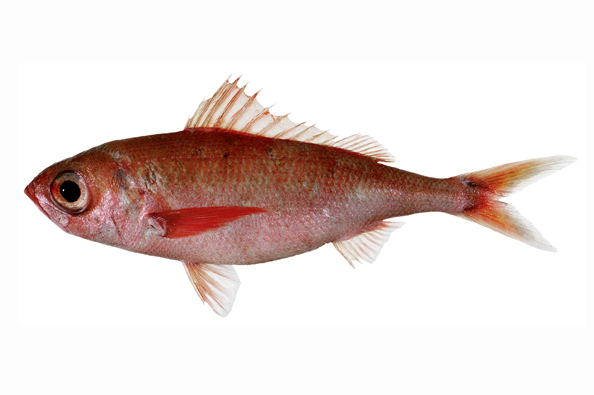Bigscale Rubyfish, Plagiogeneion macrolepis McCulloch 1914
Other Names: Big-scale Bonnetmouth, Bonnetmouth, Cosmopolitan Rubyfish, Rubyfish

Bigscale Rubyfish, Plagiogeneion macrolepis. Source: Australian National Fish Collection, CSIRO. License: CC BY Attribution-Noncommercial
Summary:
A reddish or pinkish schooling fish with a highly protrusible mouth, a single long-based dorsal fin that is barely notched between the spinous and soft-rayed parts, a deeply forked tail and yellow spots along the scale rows. Differs from the Cosmopolitan Rubyfish in having larger and fewer scales (lateral-line scales 48-51 vs. 67-74 in Plagiogeneion rubiginosum).
Cite this page as:
Bray, D.J. 2020, Plagiogeneion macrolepis in Fishes of Australia, accessed 06 Jul 2025, https://fishesofaustralia.net.au/home/species/2431
Bigscale Rubyfish, Plagiogeneion macrolepis McCulloch 1914
More Info
|
Distribution |
Endemic to southern Australia, from off Lakes Entrance, Victoria, and off western Tasmania, to off Rottnest Island, Western Australia. Occurs near the bottom on the continental shelf and upper slope in depths to 560 m. |
|
Features |
Dorsal fin XII, 11; Anal fin III, 10-11; Caudal fin 17; Pectoral fin 18-21; Pelvic fin I, 5; Gill rakers 38-44; Lateral line 48-51. Body moderately deep (28-33% SL); caudal peduncle slender. Head of moderate size (28-32% SL); eyes large (35-44% HL); mouth of moderate size, oblique, highly distensible, maxillae broad, lower jaw protruding slightly; single row of minute conical teeth at front of each jaw; no teeth on vomer, palatines or tongue. Scales moderately large, ctenoid, covering body and head including maxillae; lateral line nearly straight. Single continuous dorsal fin with low notch and moderately long base, anterior spines much longer than rays; anal fin with short base, similar to and opposite soft portion of dorsal; caudal fin deeply forked. Pectoral fins large and pointed. Pelvic fins of moderate size, based below and just behind pectoral fin bases. |
|
Feeding |
Adults feed near the bottom on larger zooplankton. |
|
Biology |
The Bigscale Rubyfish is a long-lived species that is slow-growing, slow to mature, and has low fecundity (a low reproductive output). |
|
Fisheries |
The species is taken in small numbers as by-catch in a number of trawl fisheries, and also by recreational anglers fishing in deeper offshore waters. The flesh is reportedly excellent eating. |
|
Similar Species |
Differs from the Cosmopolitan Rubyfish in its distribution and in having larger scales along the lateral line scales (48-51 scales vs. 67-74 in Plagiogeneion rubiginosum). |
|
Etymology |
The specific name macrolepis is from the Greek makros (= large) and lepis (= scale), in reference to the “much larger and more numerous” scales compared with the Cosmopolitan Rubyfish, Plagioeneion rubiginosum. |
|
Species Citation |
Plagiogeneion macrolepis McCulloch, 1914, Biol. Res. F.I.S. Endeavour 1909-1914 2(3): 104, pl. 20. Type locality: Great Australian Bight west of Eucla, 33°20'S, 126°-127°E, South Australia, depth 70-120 fathoms. |
|
Author |
Bray, D.J. 2020 |
|
Resources |
Bigscale Rubyfish, Plagiogeneion macrolepis McCulloch 1914
References
Coleman, N. 1980. Australian Sea Fishes South of 30ºS. Lane Cove, NSW : Doubleday Australia Pty Ltd 309 pp.
Gomon, M.F. 2008. Families Emmelichthyidae, Gerreidae, Sparidae, Sciaenidae, Mullidae. pp. 585-592 in Gomon. M.F., Bray, D.J. & Kuiter, R.H (eds). Fishes of Australia's Southern Coast. Sydney : Reed New Holland 928 pp.
Heemstra, P.C. & Randall, J.E. 1977. A revision of the Emmelichthyidae (Pisces : Perciformes). Australian Journal of Marine and Freshwater Research 28: 361-396 figs 1-5 https://doi.org/10.1071/MF9770361
Kuiter, R.H. 1994. Family Emmelichthyidae. pp. 595-597, figs 527-528 in Gomon, M.F., Glover, C.J.M. & Kuiter, R.H. (eds). The Fishes of Australia's South Coast. Adelaide : State Printer 992 pp. 810 figs.
May, J.L. & Maxwell, J.G.H. 1986. Field Guide to Trawl Fish from Temperate Waters of Australia. Hobart : CSIRO Division of Marine Research 492 pp.
McCulloch, A.R. 1914. Report on some fishes obtained by the F.I.S. Endeavour on the coasts of Queensland, New South Wales, Victoria, Tasmania, South and South-Western Australia. Part 2. Biological Results of the Fishing Experiments carried on by the F.I.S. Endeavour 1909-1914 2(3): 77-165 figs 1-15 pls 13-34
Parin, N.V. 1991. Three new species of the benthopelagic fish genus Plagiogeneion from the southern Pacific and Indian oceans (Teleostei: Emmelichthyidae). Proceedings of the Biological Society of Washington 104(3): 459-467 See ref at BHL
Scott, T.D., Glover, C.J.M. & Southcott, R.V. 1974. The Marine and Freshwater Fishes of South Australia. Adelaide : Government Printer 392 pp. figs.
Waite, E.R. 1921. Illustrated catalogue of the fishes of South Australia. Records of the South Australian Museum (Adelaide) 2(1): 1-208 293 figs pl. 1
Williams, A., Last, P.R., Gomon, M.F. & Paxton, J.R. 1996. Species composition and checklist of the demersal ichthyofauna of the continental slope off Western Australia (20–35º). Records of the Western Australian Museum 18: 135-155.



